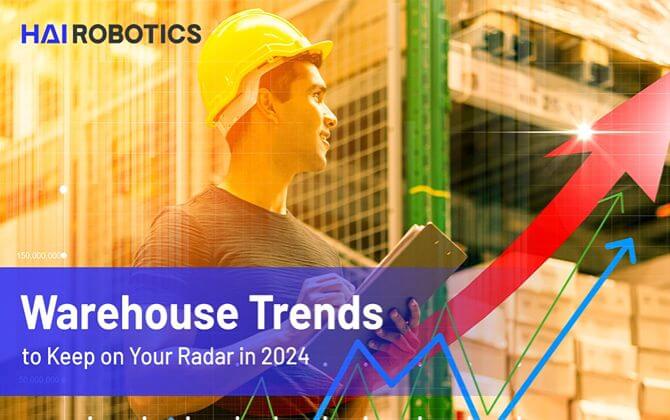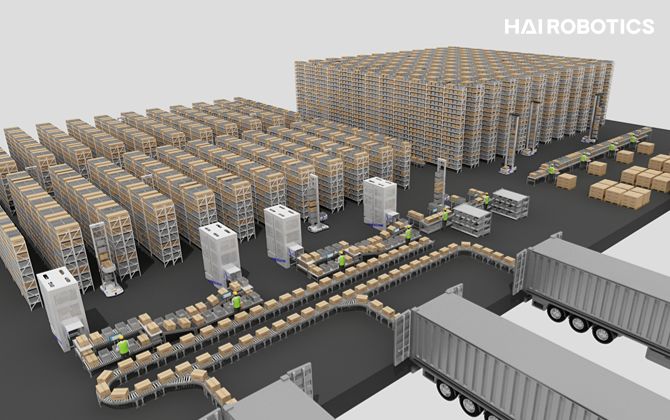3 Advanced Ways Warehouse Automation Cuts Costs and Enhances ROI for Retail and Logistics Businesses
Hai Robotics' flexible automation solutions can boost your financial positioning. This article explores the cost-saving aspects of ASRS solutions for retail and logistics companies, including hybrid warehouse environments and the importance of balancing workers and automated technology.
Hai Robotics' automated flexible solutions can boost your financial positioning
For the first in our '3 Series', Hai Robotics will dive into some of the lesser-known cost-slashing aspects of ASRS solutions for retail and logistics businesses.
We've put together an in-depth three-pronged article to help retail, logistics, and e-commerce companies understand how warehouse automation can help hit their revenue goals and set themselves up for sustained ROI.
1. Hybrid Warehouse Environments
Manufacturing and light industry labor costs are steadily rising in many regions across the globe.
Manufacturing per unit cost rose in Q1 2023 by 4.5% in the US, 9.5%, and 5.3 in the EU according to the respective government's labor reports, and the UK saw a stark decline in manufacturing productivity per hours worked in the same quarter.¹
On top of soaring inflation and minimum wage increases for many countries, these costs can eat into already trimmed budgets.
69% of light industrial business leaders used temporary workers in 2022, up 57% in 2021 according to a joint study conducted by Logistics Management and Instawork².
Fully manual warehouses that don't implement any advanced technologies conceal hidden risks and costs such as out-of-stock issues, low service levels, and unsatisfactory customer experiences such as order errors, that can be exacerbated by minimally-trained, temporary workers.
Hybrid automated systems take the best of what valued workers bring to the table and combine it into a collaborative work environment with receptive intelligent robotics.
Hai Robotics promotes an Automated Storage and Retrieval System (ASRS) solution, where robots handle more tedious, arduous, and even dangerous tasks, with people taking responsibility for more fulfilling, skilled tasks or operational decisions. Our solutions are in line with what the automation expert, Jeff Burnstein, of the Association for Advancing Automation, states in an article with Manufacturing Automation³:
"People are critical to the success of the adoption of robotics....we need to do a better job of educating people for the jobs of the future and the jobs of today; a better job of retraining the current workforce. And we need to make sure that we’re creating jobs that anybody can benefit from."
Additionally, in some markets and regions, businesses are even having difficulties recruiting either permanent or temporary workers for peak demand periods.
"There was a time when everyone was talking about robots replacing people. The current problem is that you can’t find people."—Jeff Burnstein, Association for Advancing Automation
Companies should continuously evaluate their facilities to find the best balance of workers and automated technology for their specific warehouse automation systems. Other global commercial and industrial real estate management experts also recognize how blending human intellect and technological advancements in storage spaces can reduce costs over time.
"[Finding the right mix of labor and technology] will provide operational efficiency, long-term cost control, and greater speed and flexibility across supply chains,” claims Peter Guevarra, Director, Regional Research, Asia Pacific, JLL in a 2022 article⁴.
Through the implementation of Hai Robotics' hybrid and flexible warehouse automation solution, companies can see ROI even as early as 18 months. The reason for the rapid ROI is that our automation offers multiple new streams of savings.
Some of these new and exciting revenue streams include reducing staff admin and training costs, optimizing product handling and storage costs, minimizing inventory errors, and eliminating the risk of mishandling, product loss, and workplace accidents.
2. Safe & Reliable Operations
Traditional warehouses require hard hats for a reason—they’re not the safest places.
"The number one factor driving workers’ optimism around automation (mentioned in 42% of the positive responses) was its potential to improve safety". According to a 2022 article in the Harvard Business Review⁵
Warehouses can be hazardous due to the large number and variety of goods stored, as well as various safety hazards, and sometimes even include toxic products.
Hai Robotics' pioneering Autonomous Case-handling Robot (ACR) solutions help mitigate these problems.
First, warehouse automation systems can bring products to workers instead of workers going back and forth to pick them up.
"What we’re seeing is people doing better, safer, and higher paying jobs. They’re not walking six miles in a warehouse anymore, or lifting heavy boxes."—Jeff Burnstein, Association for Advancing Automation
The decreased worker traffic reduces accidents and injuries, which improves the overall safety of the warehouse. The ergonomic designs of Hai Robotic's many autonomous solutions also provide valued workers with a safer, more comfortable work environment.
“The robots easily lift cargo…[freeing up] people to do less strenuous tasks, like controlling the machines and inventory,” claims Lilin, a packer at a casting equipment manufacturer in China from the above Harvard Business Review.
The more cargo the robots can handle and transport translates to fewer workplace accidents or injuries which can spell disaster in numerous ways for the worker and the employer.
The safety mechanisms and benefits that automation solutions provide extend beyond just the ASRS. Smart alarm devices and drainage systems, both of which automated warehouses can come equipped with, per your region's needs, can prevent and extinguish fires without delay, preserve inventory, and more importantly—save lives.
3. Streamlined & Digitized Inventory Management
'By investing in mobile devices, intelligent technologies, and data analytics systems, warehouses not only see measurable short-term results but also benefit from long-term ROI.'—Manufacturing Automation Magazine⁶
This is partly due to supply and demand data increasing in complexity, so attempting to manage it manually for automated retail companies has become unreasonable, inefficient, and costly.
A recent article by Data Channel⁷ breaks down how data management can help the retail and logistics industries:
It takes a lot of money, time, and effort to keep all the data organized manually like printers, filing cabinets, ink, and others and there will be times when you may miss out on an important piece of information that can be a game-changer for your business.
Our HaiQ software platforms alleviate data-management woes by optimizing inventory management, preventing backlogs and shortages of goods, adapting to market fluctuations, and enabling demand forecasting and just-in-time production.
Any updates or changes made in the data can be seen which will help organizations to make beneficial decisions at the right time to gain a competitive edge over their competitors.
By compiling and analyzing accurate, on-demand data, intelligent automation can track information on specific inventory locations. Smart automation can then rapidly transmit centralized data, which helps reduce errors and helps managers make better-informed decisions.
The vital importance of accurate, centralized data is a major reason Manufacturing Automation⁸ magazine has also reported the following:
'Nearly nine-in-10 warehouse operators agree they must implement new technology to be competitive in the on-demand economy, with 80% confirming the pandemic has prompted them to evolve and modernize more quickly.'
Conclusion
We understand that budgetary consideration for large retail automation companies is never a simple process. There are many stakeholders that businesses have to account for, and specific goals need to be prioritized depending on regions, departments, or timetables.
That is why it is our duty to continue to provide critical information about how warehouse automation can bring smiles to the board table centered around informed, future-focused decisions.
Discover More about how Hai Robotics can help future-proof your revenue streams and boost your bottom line with our flexible, bespoke, and efficient automation solutions.
Footnotes:
https://www.bls.gov/news.release/pdf/prod2.pdf
2. https://info.instawork.com/state-of-warehouse-labor
3. https://cdn.coverstand.com/46118/761089/ccab200642df295784bc51dc9a4c55dea68661ab.1.pdf
5. https://hbr.org/2022/02/research-how-do-warehouse-workers-feel-about-automation?
6. https://www.automationmag.com/three-new-technologies-impacting-warehouse-operations/
7. https://www.datachannel.co/blogs/the-importance-of-automated-data-management
8. https://www.automation.com/en-US/Articles/May-2022/Warehouse-Associates-Positive-Workplace-changes


